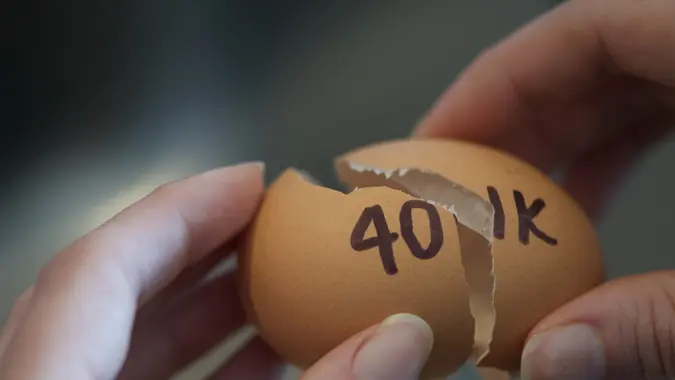Self Directed IRA: Rules, Benefits and Risks Explained

Commitment to Our Readers
GOBankingRates' editorial team is committed to bringing you unbiased reviews and information. We use data-driven methodologies to evaluate financial products and services - our reviews and ratings are not influenced by advertisers. You can read more about our editorial guidelines and our products and services review methodology.

20 Years
Helping You Live Richer

Reviewed
by Experts

Trusted by
Millions of Readers
If you’re looking for more flexibility in your retirement savings, a self-directed IRA (SDIRA) might be worth considering.
Unlike a traditional or Roth IRA that typically limits you to mutual funds, ETFs and stocks, a self-directed IRA lets you invest in alternative assets like real estate, precious metals or even private startups.
What Is a Self-Directed IRA?
At its core, a self-directed IRA works just like a regular IRA — it’s tax-advantaged and governed by the same contribution limits. The difference is in the types of assets you can hold.
Instead of being restricted to mutual funds and ETFs, you can invest in:
- Real estate (rental homes, raw land or commercial property)
- Precious metals (gold, silver, platinum — IRS-approved only)
- Cryptocurrencies (held through custodians)
- Private equity, hedge funds, and startups
- Tax lien certificates
But this freedom comes with strict IRS rules, higher fees, and greater risks. According to the Government Accountability Office (GAO), about 2% of IRAs are self-directed, holding an estimated $100 billion in assets — making them a niche but powerful tool for experienced investors.
Because you — not your broker — call the shots, SDIRAs are better suited for investors who already understand these alternative markets.
Comparison: Self-Directed vs. Traditional vs. Roth IRA
Here’s how a self-directed IRA stacks up against traditional and Roth IRAs.
| Feature | Traditional IRA | Roth IRA | Self-Directed IRA |
|---|---|---|---|
| Eligible Investments | Stocks, bonds, mutual funds, ETFs | Stocks, bonds, mutual funds, ETFs | Real estate, precious metals, crypto, private equity, tax liens |
| Tax Treatment | Contributions may be deductible; withdrawals taxed | Contributions after tax; withdrawals tax-free | Same as Traditional or Roth, depending on type |
| RMDs (Required Minimum Distributions) | Yes, starting at age 73 | None | Traditional SDIRA: RMDs at 73; Roth SDIRA: no RMDs |
| Early Withdrawal Penalty | 10% before age 59½ (exceptions apply) | 10% before age 59½ on earnings (exceptions apply) | Same rules as Traditional or Roth |
| Management | Broker or bank | Broker or bank | Custodian facilitates; investor handles decisions and compliance |
| Best For | General retirement savers | Savers expecting higher tax rates later | Experienced investors seeking diversification |
Investor note: According to the Investment Company Institute (ICI), nearly 57.9 million U.S. households own IRAs, but the vast majority are traditional or Roth. Only a small share uses SDIRAs — highlighting both the opportunity and the caution required.
How a Self-Directed IRA Works
Even though you control the investments, IRS rules require your SDIRA to be held by a qualified custodian or trustee (bank, trust company or specialized provider).
- Custodian’s role: Executes transactions, keeps records and files reports. They don’t provide investment advice.
- Your responsibility: Research opportunities, avoid prohibited transactions and manage compliance.
Funding Options
- Annual contributions (same as other IRAs: $7,000 in 2025, $8,000 if you’re 50+, per IRS)
- Rollovers from other IRAs or 401(k)s
Self-Directed IRA: Investments, Benefits and Risks
✅ What You Can Invest In
- Real estate – rental properties or commercial buildings.
- Precious metals – gold, silver, platinum, palladium that meet IRS purity standards.
- Private equity & startups – high risk, but can deliver higher returns.
- Cryptocurrency – volatile but allowed if custodian-approved.
- Tax lien certificates – earn interest on delinquent property taxes.
❌ What You Can’t Invest In
The IRS prohibits:
- Collectibles (art, antiques, wine, jewelry)
- Life insurance contracts
- Real estate for personal use (vacation homes, primary residence, etc.)
- Transactions with “disqualified persons” (yourself, spouse, children or businesses you control)
⚠️ Violations can trigger immediate taxation of the account plus penalties.
Benefits of a Self-Directed IRA
- Diversification – access to asset classes not available in traditional IRAs.
- Potential for higher returns – alternative assets may outperform, though riskier.
- Tax advantages – Traditional SDIRA = tax-deductible contributions; Roth SDIRA = tax-free withdrawals.
⚠️ Risks and Drawbacks
Illiquidity – real estate and private equity may take years to sell.
Higher fees – custodial fees range $200 to $2,000 annually, plus transaction costs.
Complex compliance – even one mistake can disqualify your IRA.
Fraud risk – the SEC warns SDIRAs are often used in scams since custodians don’t evaluate investments.
Is a Self-Directed IRA Right for You?
An SDIRA could be a smart fit if you:
- Already understand alternative markets like real estate or metals
- Want more control over retirement assets
- Are comfortable with higher fees and risk
It’s less ideal if you prefer low-cost, hands-off investing.
Final Take to GO: Balancing Flexibility With Risk
A self-directed IRA gives you the freedom to invest retirement money in alternative assets — everything from real estate to crypto. But with greater flexibility comes greater responsibility. Fees, fraud risks and IRS compliance rules mean SDIRAs aren’t for everyone.
If you’re interested, consult a financial advisor and vet custodians carefully. Want to see how an SDIRA fits into your bigger plan? Try our retirement calculator to estimate your long-term savings.
John Csiszar contributed to the reporting for this article.
Information is accurate as of Sept. 30, 2025.
Our in-house research team and on-site financial experts work together to create content that’s accurate, impartial, and up to date. We fact-check every single statistic, quote and fact using trusted primary resources to make sure the information we provide is correct. You can learn more about GOBankingRates’ processes and standards in our editorial policy.
- CNBC "What Is a Self-Directed IRA?"
- U.S. Securities and Exchange Commission "Investor Alert: Self-Directed IRAs and the Risk of Fraud"
- IRS "What if I Withdraw Money from My IRA?"
- IRS "Designated Roth Account"
- Fidelity "IRA Contribution Limits for 2024"
- United States Government Accountability Office "IRS Could Better Inform Taxpayers about and Detect Noncompliance Related to Unconventional Assets"
- Investment Company Institute "IRAs Play an Increasingly Important Role in Saving for Retirement"
- IRS "Application procedures for nonbank trustees and custodians"
- SEC "Investor Alert: Self-Directed IRAs and the Risk of Fraud"
 Written by
Written by  Edited by
Edited by 

























